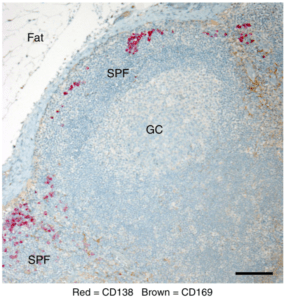
Representative immunohistochemical analysis of draining cervical lymph node from a patient with head and neck cancer showing CD169 (brown) and CD138 (red) expression. Hematoxylin nuclear counterstain (blue). Scale bar =100μm (Source Moran et al., 2018 Fig. 7c)
The hallmark of adaptive immunity is inducing long lived immunity that protects you from suffering repeated infections due to the same microorganism. Vaccines harness this arm of immunity by typically inducing long lived plasma cells and/or memory B cells (MBC) that secrete antibodies (Ab)*.Unlike plasma cells, MBCs do not continuously produce Abs and require antigen presentation to produce and secrete Abs.
The generation of the primary Ab response (after initial exposure) is well understood. However, how the secondary Ab responses with respect to where MBCs are located and how they are reactivated is not clear, Australians scientists aimed to determine this.
Moran et al., found that MBCs preferentially accumulated in a subcapsular niche they termed as subcapsular proliferative foci (SPFs). This novel structure was observed in both mice and humans. Compared with the germinal centre (GC), the SPF does not contain any CD335+ follicular dendritic cells, is Bcl-6 negative and contains significantly higher proportion of plasma cells (approximately 60%). It is at the SPF that MBCs receive signals provided by T follicular helper cells and antigen-presenting macrophages, and differentiate into plasma cells.
Researchers also showed that maintenance and survival of the SPF is not dependent on Btk-mediated BCR signalling. Blocking of Btk using ibrutinib did not affect MBC survival highlighting their antigen independence but affected the survival of GC B cells. However, Btk-mediated BCR signalling is required for the initial development and reactivation of MBCs.
In summary, the research conducted by Moran et al., suggests that SPFs are paramount in providing the right immunological niche for the development of secondary antibody responses, particularly reactivation of MBCs. Thus can be “exploited” to improve existing and new vaccines.
* Vaccines also induce long term T cell responses
Journal Article: Moran et al., 2018. Memory B cells are reactivated in subcapsular proliferative foci of lymph nodes. Nat Communications
Article by Cheleka AM Mpande










